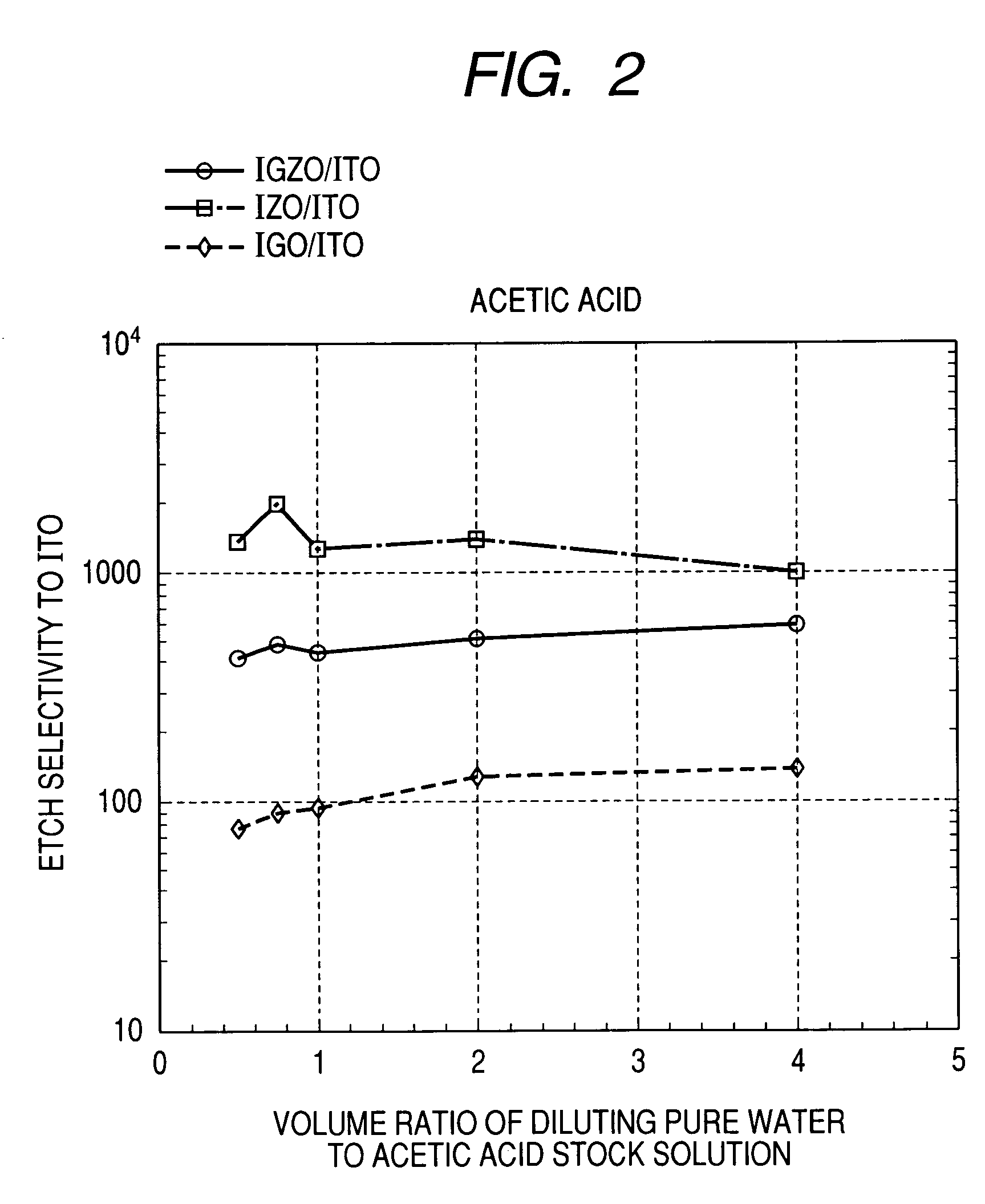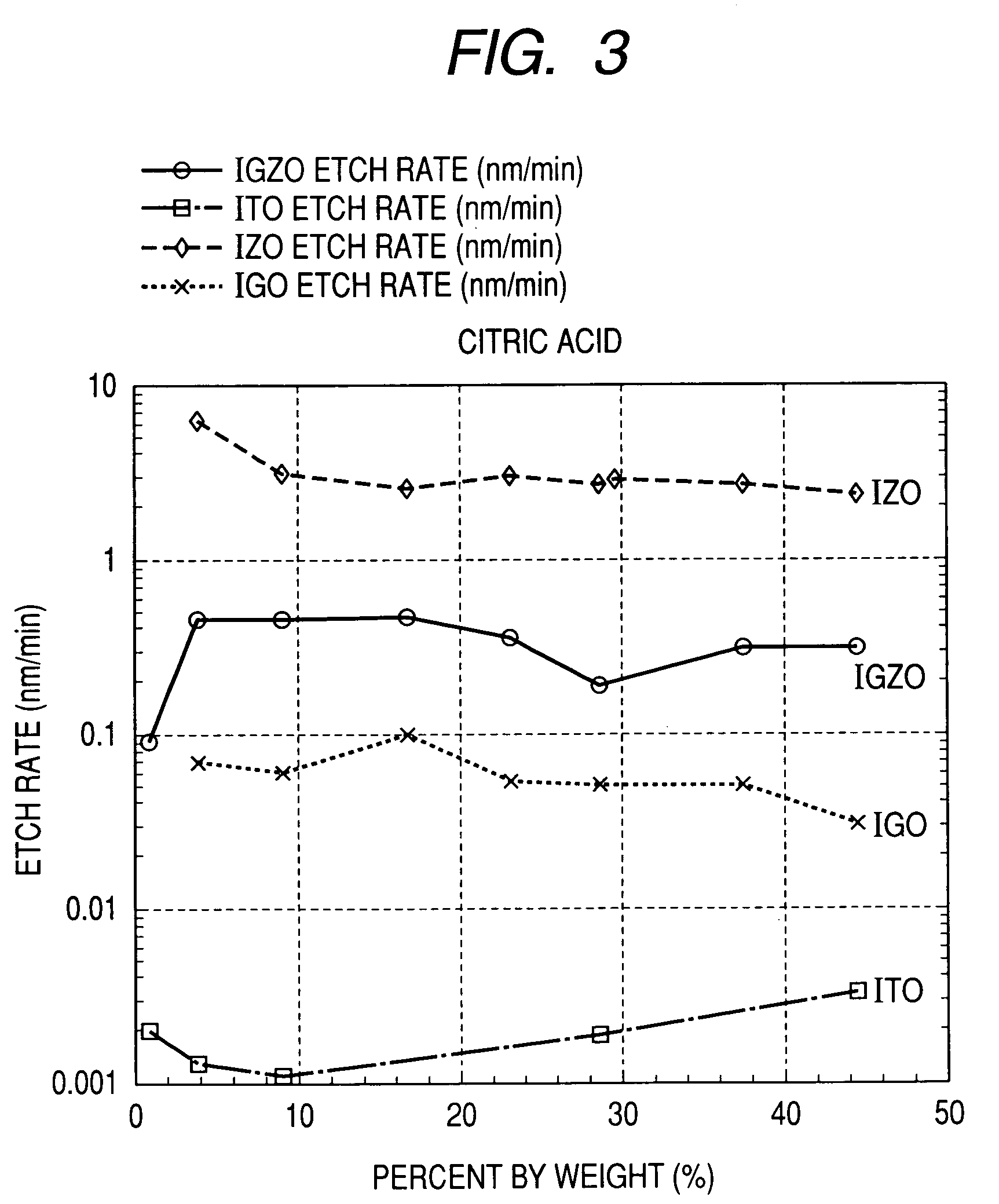Oxide etching method
a technology of oxide film and etching method, which is applied in the manufacture of final products, basic electric elements, chemistry apparatus and processes, etc., can solve the problems of reducing the production yield, contaminating the photoresist into a formed film, and melted photoresist at a high temperature, so as to achieve remarkable selectivity, precise and highly selective wet etching, and the effect of not variable performan
- Summary
- Abstract
- Description
- Claims
- Application Information
AI Technical Summary
Benefits of technology
Problems solved by technology
Method used
Image
Examples
example 1
Etch Rate Measurement
[0058]In Example 1, a specific example of an etching method of an indium oxide film including IZO, IGZO, IGO, and ITO of the present invention will be described.
[0059]First, experimental samples are produced according to a procedure described below. A Si substrate (525 mm in thickness) having a 100 nm thick Si thermal oxide film provided thereon is used as a base. Three oxide films of an IGZO film, an IZO film, and an IGO film are formed on the Si substrate with the Si thermally oxide film by reactive sputtering under the conditions shown in Table 1 below.
[0060]Incidentally, indium oxide thin films of IGZO, IZO, and IGO each containing microcrystals are deposited on the substrate by the above-mentioned spattering film deposition method. Considering that the incidence X-ray diffraction (angle of incidence: 0.5°) of the IGZO, IZO, and IGO thin films shows no clear diffraction peak, it can be said that the produced IGZO, IZO, and IGO thin films are amorphous.
[0061]...
example 2
Stack Structure
[0095]FIGS. 11A and 11B are cross-sectional views illustrating the most common etching form according to an example of the present invention. A layer 1 is a material layer with a lower etch rate, a layer 2 is a material layer with a higher etch rate, and a layer 3 (resist layer) is used as an etching mask. In usual, when the selectivity of the layers 1 and 2 of FIGS. 11A and 11B is low, the depth of excessively etched area Δd of the layer 1 of FIG. 11B and an undercut amount Δw of the layer 2 are close to each other, resulting in variation of thin film transistor devices due to etching. It can be seen that with the use of the etching liquids of Example 1, the etch rates of oxides containing indium have the relationship of IZO>IGZO>IGO> and ITO. According to the present invention, when the layer 1 of FIGS. 11A and 11B is an ITO layer and the layer 2 is one material selected from the group consisting of IZO, IGZO, and IGO, there can be obtained the highly selective etch...
example 3
Top-Gate Bottom-Contact TFT
[0096]FIG. 12 is a schematic cross-sectional view illustrating a structure of a top-gate bottom-contact thin film transistor according to one example of the present invention. Reference numerals 4, 5, 6, 7, 8, and 9 denote a substrate (e.g., glass substrate), drain electrode, source electrode, active layer (channel layer), gate insulation film, and gate electrode, respectively. Reference character L denotes a channel length. FIGS. 14A to 14K are schematic cross-sectional views illustrating production steps of a top-gate bottom-contact thin film transistor as shown in FIG. 12 using the etching liquid of Example 1 of the present invention. As shown in FIG. 14A, a glass plate having a thickness of 500 mm (manufactured by Corning; trade name: Corning 1737 glass; glass transition temperature: 640° C.) is used as the substrate 4. A polycrystalline ITO film with a thickness of 250 nm is formed on the surface of the substrate 4 by reactive sputtering, and the drai...
PUM
| Property | Measurement | Unit |
|---|---|---|
| temperature | aaaaa | aaaaa |
| temperature | aaaaa | aaaaa |
| temperature | aaaaa | aaaaa |
Abstract
Description
Claims
Application Information
 Login to View More
Login to View More - R&D
- Intellectual Property
- Life Sciences
- Materials
- Tech Scout
- Unparalleled Data Quality
- Higher Quality Content
- 60% Fewer Hallucinations
Browse by: Latest US Patents, China's latest patents, Technical Efficacy Thesaurus, Application Domain, Technology Topic, Popular Technical Reports.
© 2025 PatSnap. All rights reserved.Legal|Privacy policy|Modern Slavery Act Transparency Statement|Sitemap|About US| Contact US: help@patsnap.com



